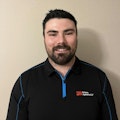Prepping for Complex Refinishing Processes
The automotive industry has witnessed a remarkable evolution in the complexity and allure of automotive colors in recent years. Special effect colors like Ford Ruby Red (RR) and Mazda's Machine Gray (46G) and Soul Red (46V) have become popular examples of the intricate and irresistible appearances that have captured the attention of both car enthusiasts and the general public in search of a new vehicle. Not that long ago, these types of colors were limited to the aftermarket custom paint scene. But they have now entered mainstream vehicle manufacturing for all types and at all price points. Along with their visual appeal, however, these complex colors also present challenges for collision repair shops across the globe, specifically in the preparation procedures required prior to refinishing.
Selling cars with eye-catching colors
The complexity of automotive colors can be attributed to advancements in paint technology and the evolving preferences of consumers. Automakers are constantly pushing the envelope to create unique and eye-catching colors that set their vehicles apart. This has led to the introduction of innovative techniques, such as multi-layered coatings and special pigments/metallics, which allow for a greater depth and richness in color. The demand for personalized and distinctive vehicles has also driven the development of more complex color options, catering to the diverse tastes and desires of consumers in the modern automotive industry.
Why surface preparation has changed for complex colors
Unfortunately, the increasing complexity of automotive colors does not come without its challenges, particularly in refinish procedures. Surface preparation has always involved sanding the repair area to create a smooth surface for refinishing. However, the finely ground metallics used in complex colors can pose difficulties if not applied with precision over the correct surface profile; they can be so small that there is a risk of these particles falling into sand scratches if the surface is not sanded fine enough. The result is an uneven distribution of metallic flakes, affecting the final appearance of the repaired area so that it doesn't match adjacent areas, not only telegraphing that a repair was attempted but also failing to meet customer expectations in delivering a superior repair.
Not all that long ago, it was generally a common practice among refinish technicians to finish-sand using P400-P600 grade abrasives. When waterborne basecoats were introduced, though, visual appearance inspections resulted in a greater number of failures and technicians became more aware of the critical relationship between the metallics and the depth of sand scratches left behind after surface prep. As the use of waterborne basecoats increased, refinish technicians were required to adapt and shifted to finish sanding these advanced coating systems with finer abrasives in the P600-P1000 range.
More recently, Ford's unveiling of its Ruby Red (RR) and Mazda's debut of Soul Red (46V) and Machine Gray (46G) heralded the broad expansion of available tri- and quad-coat systems, and refinish technicians have once again found challenges within their current processes. Paint companies continue to publish bulletins to help overcome the challenges these colors present, and while many of the solutions can be found in the paint both, the need for proper preparation prior to the vehicle being sprayed cannot be forgotten.
By technically examining the surface preparation of these complex colors at the micro level, we can understand the realities of these coatings and determine what is required to prepare the substrate correctly. These intricate colors can contain extremely fine particles, sometimes referred to as leafing aluminum or high brightness small metallic flake. As mentioned earlier, these tiny particles can easily fall into typical sand scratches, rather than bridging across them. Often these colors require an even finer sand scratch profile, moving into the P1200-P2000 range, depending on the paint manufacturer. In addition to finish-sanding your basecoat blend area in a finer grade, you may also have to sand your primer sealer after applying it to ensure it meets the requirements of the color system.
Each paint manufacturer has a specific process detailed for these complex colors. While they all differ, almost all of them call out the need for an extremely fine sand scratch profile to ensure a desirable outcome. In addition, technicians must stay updated with the latest advancements in paint technology and refinish techniques. Training programs and certifications from manufacturers can provide them with the necessary knowledge and skills to effectively handle complex colors as well as overcome the challenges they present.
It is important to note that the challenges posed by complex colors in collision repair preparation are not insurmountable. With proper training, manufacturer guidance and attention to detail, technicians can successfully navigate these complexities and deliver exceptional refinishing results. The key lies in understanding the unique characteristics of each complex color and employing the appropriate techniques and tools to achieve a flawless finish.
The takeaway
The increasing complexity of automotive colors, exemplified by Ford RR, Mazda 46G, and 46V, has introduced challenges for traditional refinish surface preparation procedures. The finely ground metallics used in these colors require meticulous ultra-fine sanding techniques to avoid uneven distribution and achieve a seamless repair. By adapting their processes, utilizing specialized products, and staying updated with the latest advancements in paint technology and repair procedures, collision repair technicians can overcome these challenges and ensure a superior finish that seamlessly matches the complexity and allure of these captivating automotive colors.
About the Author

Connor Alexy
Connor Alexy is an application engineer at 3M in the Automotive Aftermarket Division, focusing on the paint shop side of collision repair as well as adjacent markets. He has worked in and around the industry for eight years in a variety of roles, from working in shops to technical testing and training. Connor holds a bachelor’s degree in Applied Technical Management / Leadership as well as an AAS in collision repair from Dunwoody College of Technology.

